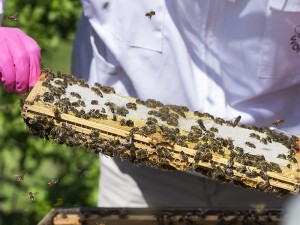
Many of us quite fancy the idea of keeping bees but because it appears so daunting, very few of us actually do anything about it. So join us, learn the basic skills and get help at every step on the road to self sufficiency in this rewarding craft.

STARTING
In the beginning you have to decide where you might keep your bees, what hives you will use and how to acquire the bees themselves.
-
Location
It is much more convenient to keep bees at your home because it is easier to look after them. Is your home a suitable place for 1 hive or more? If you are in doubt, we can help you. If not, then we might be able to help you to find somewhere else to keep them. But remember, you will have to be prepared to travel regularly to look after your bees.
-
Hives
There are several types of hives, each of which has its adherents. Almost all local beekeepers use the National hive, so that second hand equipment is more likely to be available. A new hive will cost you nearly £300 but few of us have spent that much. Second hand equipment may cost about £100-150 but will need careful cleaning. Once you have your equipment, it should last for years.
I found a local beekeeper who was giving up because his back was giving out and hives full of honey are heavy. I also bought from our own auctions, where members reduce their own stocks of equipment. And then there is eBay! If you buy used equipment, you will probably need to buy wax foundation. For a brood box and 2 supers, this will cost about £20 and you will probably have to buy a little more each year.
-
Bees
Here you have to rely on local beekeepers and there are 3 possibilities: a complete colony, a nucleus and a swarm. Commercially a nucleus will cost about £110. You might be lucky enough to buy a colony from a fellow member for about the same. But a swarm is free. The first 2 should be in good health and settled but the swarm may have attendant dangers, being an unknown quantity.
I started with a nucleus and then helped to collect a swarm, which promptly flew away. That was replaced eventually by a second swarm which made its home with us.
Equipment
Finally you need protection and that means a jacket with veil and boiler suit/trousers. You need wellies, which you probably have already, and gloves. Household rubber gloves are a good compromise between protection and the sense of touch. And you will need a smoker and a hive tool.
WORKING THE BEES
Beekeeping is mainly a summer occupation, since the bees spend the winter quietly in their hives.
-
Preparing for winter
Bees do not hibernate but maintain a more or less constant temperature throughout the year. In the winter they cluster and burn up their stores to maintain that temperature. So your last activity is to ensure that they have sufficient stores to see them through the winter. This is usually done through feeding sugar syrup, so you have to buy a few bags of sugar. There are different feeders on the market fbut we started with an inverted honey jar with pierced lid.
-
Spring/Summer
Your bees have come through your first winter.
You have to check their condition and development. Hopefully they are doing well. You now need to check them every week. This is most important as the swarming season approaches and you do not want to lose half your stock.
-
Summer/Autumn
In your first year, you will probably not have much honey – unless you started early with a full colony – so you will perhaps take a little honey for yourself and leave the rest for the bees. However, in later years you will have to extract the honey and you can hire the association extractor.
Each jar of honey sells for at least £5, more if you sell privately. So, once you have bought your equipment, you can start to build up savings to expand your apiary!

